After investing in the value of Cedar to clad your home you will want to make sure that you can maintain the appearance and integrity of the Cedar.
The most common problems that occur with Cedar cladding and timber features on your home are:
(1) Cupping of boards
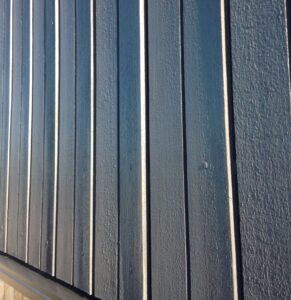 Cupping occurs when the timber has been left unprotected or the timber stain or wood oil surface treatment ceases to be an effective barrier to the weather. This allows moisture to enter the timber, and as it evaporates more quickly from the surface, it causes the timber to shrink on its outer face, causing the cupping effect.
Cupping occurs when the timber has been left unprotected or the timber stain or wood oil surface treatment ceases to be an effective barrier to the weather. This allows moisture to enter the timber, and as it evaporates more quickly from the surface, it causes the timber to shrink on its outer face, causing the cupping effect.
This will, in time, become unsightly, cause the boards to pull away from the nails or cause them to split. Eventually it may lead to weather-tightness issues.
The solution is to ensure that you have an adequate surface treatment, such as wood oil or timber stain, applied from new, and consistently maintain that treatment. Depending on the exposure of the cladding to the weather, most wood oils or stains will give between 3-5 years of protection. After that, you risk cupping!
(2) Discolouration due to contamination
 Discoloration comes in many forms. The first, and easiest to solve, is discolouration from contamination.
Discoloration comes in many forms. The first, and easiest to solve, is discolouration from contamination.
It may be caused by dust and dirt build up, airborne fungal spores, salt air, pollution from vehicles and roads, construction sites or other nearby industrial or agricultural activity.
To help reduce this you simply need to regularly give the cladding a ‘soft-wash’ with water. In most cases there is no need to use chemicals or a power wash with a water blaster.
If you are a DIY person, and your house is not too high, you can do it yourself. First use a soft broom to gently lift off any cobwebs. Then using the hose with a spray nozzle attachment start from the bottom and gently and systematically hose of the cladding until you get to the top. Then give it a rinse down.
Don’t be tempted to brush or scrub the cladding while you are washing as this can damage the surface coating. Don’t use bleach products, as these will change the colour of the contamination but won’t necessarily remove it. It will also mark the Cedar cladding.
Sometimes the contamination may be dark or black spots in behind the surface treatment. If so, contact us to assess it and recommend a way to remove it.
(3) Tannin staining and silvering
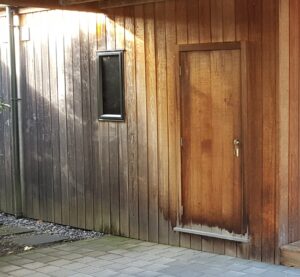 A common problem with Cedar is tannin staining. Like many species of timber, Cedar wood contains tannins. When moisture enters the unprotected surface or ends of the Cedar timber the water-soluble tannins migrate to the surface of the timber causing the dark tan to black discolouration. The areas that are more exposed to the weather and rain have these tannins washed away and become dull and grey (silvering).
A common problem with Cedar is tannin staining. Like many species of timber, Cedar wood contains tannins. When moisture enters the unprotected surface or ends of the Cedar timber the water-soluble tannins migrate to the surface of the timber causing the dark tan to black discolouration. The areas that are more exposed to the weather and rain have these tannins washed away and become dull and grey (silvering).
While silvering may have a rustic charm, unfortunately, most silvering is a sign of damage to the outer layer of the Cedar.
Silvering is caused by the fraying and loosening of the top cells of the Cedar under long-term UV exposure. Technically this is photo-oxidation. The weather and sun not only damage the outer fibres, but they also further deplete the natural oils of the timber. Hence it loses its original colour and become silver.
When the timber is damaged in this way it is becomes defenceless against the other detrimental elements such as mildew, mould, moss, lichen, and moisture.
(4) Discolouration due to mould development
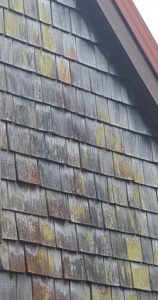 If you see brown, black, red, green, or white patches developing on your Cedar, it is likely to be mould. Generally, the mould problem will be aesthetic and not actually cause a decay to the underlying timber. However, it is unsightly and is an indication of a more serious problem, excessive moisture retention. If left too long it can cause staining, so it is best to treat it early. White moulds are some of the most stubborn to remove and may permanently mark the timber.
If you see brown, black, red, green, or white patches developing on your Cedar, it is likely to be mould. Generally, the mould problem will be aesthetic and not actually cause a decay to the underlying timber. However, it is unsightly and is an indication of a more serious problem, excessive moisture retention. If left too long it can cause staining, so it is best to treat it early. White moulds are some of the most stubborn to remove and may permanently mark the timber.
Most moulds can be cleaned from the timber using a chemical cleaning agent. While many recommend bleach solutions, we don’t. Bleach type cleaners may only change the colour of the mould and can cause streaking on the Cedar, which is as unsightly as the original mould problem.
The key to avoiding mould developing is the application of a surface treatment such as a timber stain or wood oil which will provide a protective coating that sheds the water from the surface of the timber. Wood oils contain anti-fungal properties which will also help inhibit the development of mould. After that it is a matter of keeping your cladding clean by means of regular light wash downs that will remove the dust and other contaminants that can harbour or trap the airborne mould spores on your Cedar.
(5) Darkening of the timber due to moisture retention.
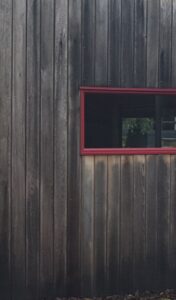 If you notice the weatherboards on your home stay dark after the rain, it is likely that they are absorbing and retaining moisture. It is also can be the result of the timber having contact with the ground, other timber such as the deck, or being too close to the flashings. This will allow the cladding, through the process of osmosis, to absorb the moisture into the timber.
If you notice the weatherboards on your home stay dark after the rain, it is likely that they are absorbing and retaining moisture. It is also can be the result of the timber having contact with the ground, other timber such as the deck, or being too close to the flashings. This will allow the cladding, through the process of osmosis, to absorb the moisture into the timber.
As a result of excess moisture, you will have the development of mould or fungi, increase the likelihood of cupping and timber rot, and the possibility that the moisture will migrate into the interior of your home.
To prevent this, it is important to ensure that your Cedar is protected by maintaining the surface treatment of timber stain or wood oil. You should also ensure that the timbers are not touching the ground or garden and are not tight fitting against flashings or other timber structures.
(6) Weathering of the boards
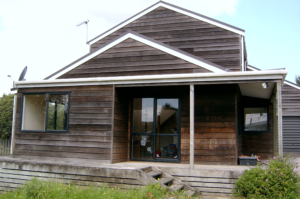 Weathering of the boards is the result of the combined effects of the sun, rain, and wind eroding away the softer timber fibres of the cladding. This results in patches of timber with a rougher surface that reflects the light differently to the smoother sections, leaving you with a patch-work effect on your Cedar walls.
Weathering of the boards is the result of the combined effects of the sun, rain, and wind eroding away the softer timber fibres of the cladding. This results in patches of timber with a rougher surface that reflects the light differently to the smoother sections, leaving you with a patch-work effect on your Cedar walls.
Not only are weathered boards unpleasant to look at, but they are also more likely to retain moisture and trap dirt, dust, fungal spores, and other contamination on the timber. This leads to mould or mildew growth.
Extreme weathering will eventually reduce the thickness of the timber, and particularly on profiled weatherboards, make them more prone to splitting.
Protecting your timber with a timber stain or wood oil is required to prevent weathering and will maintain its consistent appearance.
(7) Opening up of joints and corners, pulling away from the fastenings.
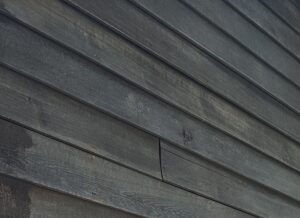 While Cedar is a very stable timber, it will still be affected by the constant effects of moisture and heat.
While Cedar is a very stable timber, it will still be affected by the constant effects of moisture and heat.
When it is left unprotected moisture will start to be absorbed into the timber. As it dries, the outer face of the timber will start to shrink. This results in cupping of the boards and the opening up of the joints and corners. Due to the constant movement, it may also start pulling away from the fastenings or nails.
To rectify these issues, you may need to add flashings to the joints and corners, or box-in the corners. If the boards are pulling away, you may be able to gently re-fix them with screws. However, care needs to be taken so that you don’t split the cladding. If left too long, you will be faced with replacing the Cedar.
The better solution is to ensure that you keep up the maintenance by regularly cleaning and then apply a timber stain or wood oil. This will help prevent the moisture entering the timber in the first place. It will also mean that your property looks great, and that will add to its value.
(8) Decaying or timber rot at ends of boards and corner mouldings
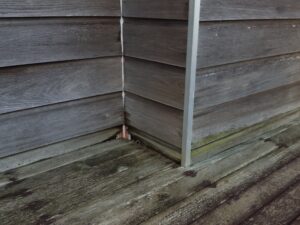 When the cladding or corner moulding comes into constant contact with the ground, other timber structures such as decks, the flashings, or plants that are planted too close to the wall, it will start to retain moisture. This causes the onset of timber decay or rot which will affect not only the lower boards, but also the bottom plate and studs of the building.
When the cladding or corner moulding comes into constant contact with the ground, other timber structures such as decks, the flashings, or plants that are planted too close to the wall, it will start to retain moisture. This causes the onset of timber decay or rot which will affect not only the lower boards, but also the bottom plate and studs of the building.
To prevent this, you need to ensure than the timber is not in contact with the ground or flashings and make sure that plantings are kept well clear of your cladding. This will allow airflow and help the timber dry out.
In some cases, you may need to shorten or cut back the bottom boards so that they don’t come into contact with the ground or flashings.
(9) Development of mildew, mould, moss and lichen
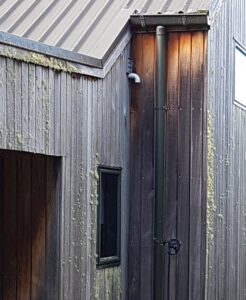 Cedar wood consists of cellulose, a substance contained in the cell walls of all plant materials. Cellulose provides an ideal nutrient for many mould varieties. To exacerbate matters further, Cedar is high porosity, meaning that it can absorb and trap moisture. The combination of moisture and cellulose provides mould or mildew spores with everything they need to grow and multiply.
Cedar wood consists of cellulose, a substance contained in the cell walls of all plant materials. Cellulose provides an ideal nutrient for many mould varieties. To exacerbate matters further, Cedar is high porosity, meaning that it can absorb and trap moisture. The combination of moisture and cellulose provides mould or mildew spores with everything they need to grow and multiply.
Moss and lichen, although from different families, will take root in moist and dirt laden cladding. While moss (like a green carpet) tends to sit on the surface, lichen (like small trees or plants) extends its roots into the timber and can’t just be washed off.
Therefore, the best way of controlling mildew, mould, moss, and lichen is to keep the exterior timber clean and dry. This is best achieved by apply a timber stain or wood oil to the cladding, and then keeping it clean by means of annual wash downs.
If you already have moss, lichen, or mould on the cladding on your property we recommend that you contact a Cedar maintenance specialist to assess and advise what is the best way to treat it and then protect the cladding from further deterioration.
If you are not sure about any of these matters, contact us for some advice.
Learn more about what you can do to maintain the Cedar on your home by reading our articles What You Need to Know about Caring for the Cedar on Your New Home and Why Cedar Needs Special Care to Maintain Good Looks and Value.
